



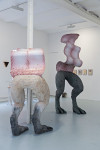
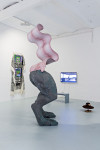
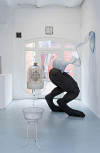
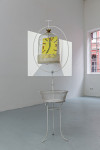
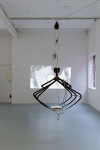
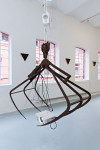
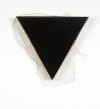
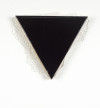
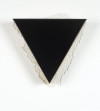







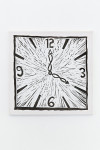
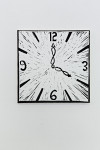



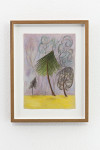
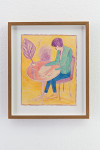
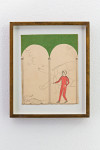
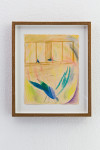
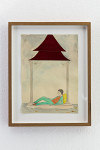
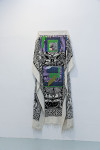
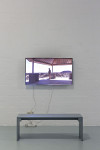


Henning Bohl, Raphaela Vogel, Nicola Brunnhuber, Stephan Dillemuth, Isabelle Fein, Jutta Koether, Chris Kraus, Frances Scholz, Anne Speier
Fantasie
The exhibition "Fantasie" belongs to a three-part series which will be continued in 2017. It pursues an interest that was already the starting point of considerations of two shows at Halle fuer Kunst: On the one hand, the interest in the moment of ambiguity and ambivalence in contemporary art ("On Radical Juxtaposition", 2014), on the other, the interest in Kenneth Anger’s notion of film and therefore of cultural and artistic production as a magic ritual, which appears contrary to what today manifests itself as a both deeply ambivalent and questionable art field permeated by economic and power interests ("Magic Lantern Cycle", 2015).
While the first part of the series engages with the concept of imagination, the second turns to the notions of authentic - inauthentic and the third to gestures and expression. All three are grasped as interconnected aspects of thinking about artistic practice and are based on the attempt to find concepts for those moments that interest one in works of art – i.e., to positively designate aspects that are met with interest and response, and not only to use a negation to formulate the fact that quite a bit of contemporary art exhausts itself to a high degree in running through references, in evoking a critical impetus, in a vocabulary schooled in discourse, or in glossy superficiality. Surprisingly, this attempt has brought notions to the fore that are regarded as rather obsolete and reactionary (imagination, authenticity,expression). Which is in turn interesting, too, because it seems to reveal a desire to utilize these concepts for contemporary art as well, since they can apparently name something that has to do with the surplus value and essence of art, meaning not just knowledge and experience, but also the ability to generate intensities. The exhibition series therefore seeks to approach these notions with the awareness of how they are charged and how questionable they are, beyond a clichéd understanding, in order to find out how far and in which direction they can take us. However, the situation has become more complicated in recent years. Against the background of an increasingly stronger criticism of emptied critical or politicized art practices, evoking these moments may not be generally suspected of contributing to a hopelessly antiquated concept of art anymore; but in the wake of the critique of the "political as style" (James Meyer), one must now be careful not to allow a "new sensibility", an "intensity as style", to creep in, based on the reactivation of a notion of the autonomy of art restricted to the formal.
Imagination is first of all the foundation of all cognition, for according to Aristoteles, the soul does not think without images. Although it is a moment that constructs reality, there is a difference between images of mathematical or philosophical deliberations, for example, that ultimately remain imaginary, and those of artistic production during which one’s imagination transfers imaginary images to real images. Even if – or precisely because – this is basically true of all artistic practices, the interest guiding the exhibition goes beyond merely ascertaining this fact and aims at artistic works that quite explicitly address imagination as desire, as the driving force of artistic production, without seeking to control it; works that do not shy away from the imagination on which they are based and thus integrate voids, incalculability, affects, and desire. Alongside such basic considerations, the focus is also on an art fueled by imagination that seeks what is possible as opposed to what exists. At issue is the development and invention of worlds, languages, and spheres that situate themselves next to or beyond reality (toward fantasy and fiction). Appropriating the world by inventing the world. This immediately gives rise to the question of whether imagination is a possibility to create alternatives to and descriptions of what exists, or whether it is to be regarded more as an escapist withdrawal into private universes and thus "worldless", to use Hannah Arendt’s words. And does such an art immediately make itself vulnerable, because the accusation of Marxist art critique applies to it, namely, that revolving around sentiments, inwardness, affects, and one’s own artist’s position follows late-capitalist logics? What would a regressive concept of imagination be, and where does the border to a progressive one lie? If a proximity to Harald Szeemann’s individual mythologies arises here, then the constitutive (and constructive) function of imagination for the sphere of the political must also be marked. The latter has been increasingly discussed in recent years, most intensively in the series "Phantasm and Politics" organized by Helmut Draxler and Christoph Gurk at HAU (Hebbel am Ufer) in Berlin. Freud, and later Lacan, already stressed the constitutive role of the imaginary (Lacan used the term phantasm), albeit for the human psyche and the resulting construction of reality (or what are regearded as such). This aspect of constituting, which is characteristic of imagination, already makes it clear that the exhibition is not about (and cannot be about) establishing a dubious opposition between imagination and concept, and thus contributing to a naturalization, for the reason that thought and imagination always have the same origin, since one cannot be had without the other. Hence, imagination as such is never essentialist, even if it is at times essentialized. Yet, like with the "fantasia" as a form of musical composition, it is accompanied by associations of emotionality and expressivity, creating an opening that leads away from the here and now. So if, according to Christina von Braun, imaginary spaces are zones of inaccessibility and incalculability, and imagination is thus the retaining of spheres "that needn’t correspond with the world, that make no claim to reality, meaning that they do not lay claim to the possibility of becoming material or visible", what does this tell us about art? Is artistic practice a taming of imagination? Just like psychoanalysis that seeks to grasp the spaces of invisible images and translate them into a language? All these considerations on imagination, which are based on an interest in an art that cannot be arrested or frozen, but reveals moments that are not intent on being understood or creating evident contexts (of meaning) informed by factual reality, form the exhibition’s frame of reference, whereby the works on display stand for themselves and merely mark a starting point for the ideas, concepts, deliberations, and notions formulated above.
Programme
Reading group
"Venusia" by Mark von Schlegell, 2005
Wednesday, 18 May 2016
Tuesday, 24 May 2016
Tuesday, 31 May 2016
Wednesday, 08 June 2016
Wednesday, 15 June 2016
each 6-8pm
"Members guide members" with Andreas Peschka
Thursday, 26 May 2016, 6.30pm
Workshop "Art histories" with Bernd W. Plake
Saturday, 28 May 2016, 2-6pm
For children from the age of 7, teenagers and adults
Screening
"Amboy" (Frances Scholz, 2014) and "Episodes of Starlite" (Frances Scholz, 2010 - 2012)
Wednesday, 01 June 2016, 7pm
Scala Programmkino, Apothekenstraße 17, 21335 Lüneburg
Lecture by Marcus Steinweg
Tuesday, 07 June 2016, 7pm
Comic-Workshop with Anna Prinz
Saturday, 11 June 2016, 11am-1pm
For children and teenagers aged 6 to 14
"Art and Cake"
Sunday, 12 June, from 3pm
Guided tour
Thursday, 16 June 2016, 6.30pm
Screening
"Gravity & Grace" (Chris Kraus, 1996)
Friday, 17 June 2016, 7pm
Scala Programmkino, Apothekenstraße 17, 21335 Lueneburg
Reading by Mark von Schlegell
The date will be announced shortly
Halle für Kunst is generously supported by Land Niedersachsen, Sparkassenstiftung Lüneburg, Lüneburgischenr Landschaftsverband, VGH-Stiftung, Lüneburger Bürgerstiftung and Hansestadt Lüneburg.